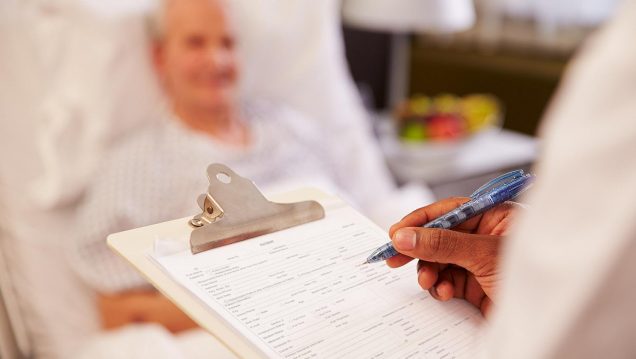For First-Year Med Students, Face Time With Patients Builds Lasting Confidence in Addressing Social Needs
This article originally appeared in Boston Medical Center’s HealthCity on Monday, Feb. 3. The article was written by Ray Hainer.

In 2014, a small group of trauma surgeons and medical students came together to found Socially Responsible Surgery (SRS), an organization with the goal of establishing social responsibility as a core value of surgical practice. The group’s first informal meetings, at Boston Medical Center (BMC) and the Boston University School of Medicine (BUSM), soon gave rise to a host of research, education, and advocacy initiatives, and SRS is now a fast-growing national nonprofit with chapters at the UC Davis School of Medicine and the University of Kansas Medical Center.
Integrating social determinants of health (SDOH) into medical education and training is a cornerstone of the organization’s efforts. One of the most notable SRS-led programs to take root at BUSM is a service-learning project (SLP) centered on SDOH that pairs first-year medical students — a green group eager for clinical experience — and surgical patients.
The first-years instruct the patients how to prepare for and recover from their procedure. They also screen for SDOH, asking about needs including housing instability, substance use disorders, food insecurity, and violence in the home or community — risk factors that are often missed in surgery patients but can have a major impact on outcomes. After these consultations with patients the med students report back to the care team and help devise a plan of action if needed.
The SLP was the brainchild of Megan Janeway, MD, who cofounded SRS as a BUSM student and is now a third-year surgery resident at BMC. As an intern, Janeway recalls, she and her peers were responsible for patients on the trauma floor — a busy surgical service with high patient turnover — and she felt they didn’t have enough time for patient education. The SLP was designed to fill that gap and also give med students invaluable experience with SDOH in a clinical setting, not just a classroom.
“You learn all these structured elements in medical school,” Dr. Janeway says. “You ask patients how their head or chest or abdomen is doing. What are their vital signs? What are their labs? You check all these boxes. Social determinants of health has never been part of that, and we’re trying to create a teaching in which every student, when they leave here, goes out into the world as a physician — in whatever specialty — and talks to every patient about the social determinants of health.”
“We’re trying to create a teaching in which every student, when they leave here, goes out into the world as a physician — in whatever specialty — and talks to every patient about the social determinants of health.”
– Megan Janeway, MD
Now five years old, the SLP appears to be having the desired effect. In a recent paper published in The American Journal of Surgery, Dr. Janeway and her SRS colleagues found that students who participated in the project reported feeling more valuable to the surgical teams and more confident interacting with patients and screening for SDOH.
The long-term impact on students was striking. Janeway and colleagues followed the students for up to four years after their service-learning year, and with each successive year a greater proportion of students said they’d learned useful patient education skills during the SLP — suggesting that their understanding of the project’s value only grew over time.
The study also points to the SLP’s positive influence on students’ perceptions of surgery and their interest in pursuing a surgical career. Nearly half of the participants said they intended to pursue a residency in general surgery or a surgical specialty — an encouraging response at a time when surgeons in the U.S. are in short supply.
“I had a biased view of surgery before starting this SLP,” one participant wrote in a survey. “I was a public health major with only exposure to primary care. I didn’t know ANY surgeons and only knew what I had heard about surgery. In contrast, I’ve found through my experience with this SLP that surgery is a field that cares about and surrounds itself with the [social determinants of health].”
Dr. Janeway’s paper carries the usual limitations of a small, qualitative study. Still, the lift in self-efficacy and real-world skills it describes is harder to accomplish than it looks and is a critical missing piece for many med students, says Sabrina Sanchez, MD, a trauma surgeon at BMC and Assistant Professor of Surgery at BUSM, as well as a faculty advisor to SRS.
“There is a very steep learning curve from being a non-clinical medical student in your first two years of school to then being a clinical student and being expected to compassionately and effectively interact with patients as soon as you become an intern,” Dr. Sanchez says. “Getting students to interact with patients early on and practice developing rapport gives them more time to get acclimated … and allows for greater comfort with these interactions in their clinical years. When clinicians feel comfortable and confident interacting with patients, it results in patient’s feeling comfortable in return, which greatly increases the success of the patient-doctor relationship.”
As with SRS’s other activities, Dr. Janeway and her colleagues hope to scale this service-learning approach to other SRS chapters and surgery programs everywhere. These SLPs are simple to implement, inexpensive, and easy to sustain, Janeway notes, and the early results from Boston suggest they add significant value to clinical teams and med students alike.
“Thinking outside the box, trying new and different things and seeing how they work — I think that’s how you make progress in medical care,” Dr. Janeway says. “We hope to help build up other programs across the country to have the same success we’ve had.”